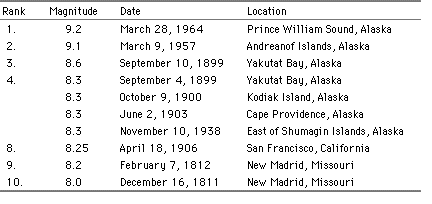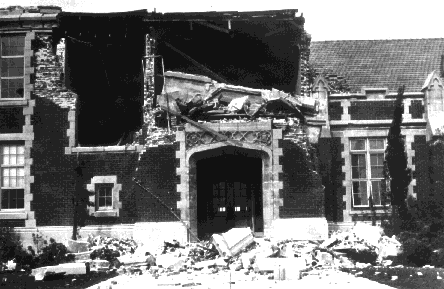SLU
EAS-A193 Class Notes
|
SLU EAS-A193 Class Notes |
|
An earthquake is the sudden movement of the ground that releases elastic energy stored in rocks and generates seismic waves.
These elastic waves radiate outward from the "source" and vibrate the ground.
Earthquakes are not the exclusive cause of seismic wave; explosions, planes, wind, storms, and people also vibrate the ground.
|
In an earthquake, the initial movement that causes seismic vibrations occurs when two sides of a fault suddenly slide past each other. A fault is a large fracture in rocks, across which the rocks have moved.
Faults can be microscopic or hundreds-to-thousands of kilometers long and tens of kilometers deep. The width of the fault is usually much smaller, on the order of a few millimeters to meters. |
|
The size of an earthquake depends on
Small earthquakes rupture small faults or small sections of large faults. Fault movement during such events is quick, small quakes last only a fraction of a second and the rocks on either side of the fault don't move very far.
Large earthquakes rupture faults that are tens to thousands of kilometers long. Such ruptures can take minutes to complete, so strong shaking near the earthquakes can last several minutes and rocks across the fault can be offset tens of meters during very large earthquakes.
The most commonly used quantification of earthquake size is the magnitude.
|
Magnitude is an instrumental measure of the amplitude of ground shaking; that is, you must have an instrument called a seismograph to measure the magnitude of an earthquake. Fortunately, large earthquakes are less frequent that small earthquakes. The temporal distribution of earthquakes by size follows a logarithmic rule. |
 |
Earthquakes are not isolated events, they occur in sequences. Most often, each sequence is dominated by an event with a larger magnitude than all others in the sequence (usually about one magnitude unit larger).
We call the large event the mainshock, and the events that follow are called aftershocks.
Occasionally, the mainshock is preceded by an event or events that we call a foreshock(s).
Sometimes, earthquakes occur in interesting sequences which we call doublets, triplets, multiplets, or swarms depending on how many similar-size events are in the sequence.
|
Earthquakes are the result of slow-moving processes that operate within Earth. Earth was hot when it formed, and has been cooling ever since (near the surface, for each km into Earth, the temperature rises by about 30deg. Celsius). Earth's cooling causes the portions of Earth to move, and that movement is what we call an earthquake. We will discuss the details later.
|
|
Earthquakes in populated regions have killed many people and have destroyed entire communities.
China has been hit especially hard
In recent years (the 1990s)
In the US, we have been fortunate to avoid such disasters, the largest earthquakes in U.S. history occurred decades ago, before the dramatic increase in population in earthquake-prone regions.
During the last hundred years there has been an average of about 17 large earthquakes each year.
Millions have lost there lives in significant earthquakes. Although these deaths occur in discrete events, if we average that number killed over the century, we lose about 15,000 people per year.
Cleaning up and repairing damage after earthquakes is expensive.
Alaska is the most seismically active state, the host of seven largest earthquakes in U.S. history. Hawaii is also earthquake-prone, and although dangerous, these events are not often the of the largest size.
California is the most active of the lower 48 states, and its large population increases the potential for a disaster.
Other states that have experienced damaging earthquakes include Washington, Oregon, Nevada, Idaho, Utah, Wyoming, Missouri, Arkansas, and South Carolina.
The 1811-1812 earthquake sequence that struck the New Madrid region of southeast Missouri rank in size with large earthquakes in California and Alaska.


A number of factors must be considered when assessing the likely damage due to an earthquake.

Estimating the probability of a large earthquake is a difficult challenge and research on the subject continues.
The best estimates we have are

Preparation is the key to living with earthquakes. Preparations can be long-term or short-term, community or personal.
Here is a list of some of the steps that will help you deal with an earthquake:
No, during the 1933 Long Beach, California earthquake, two-thirds of the people killed were crushed by falling masonry as they rushed out of a building during the shaking.

